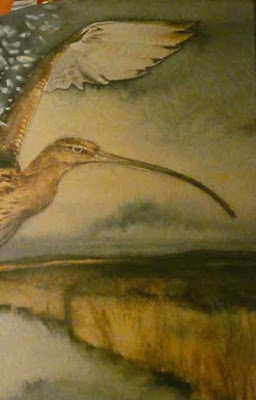Spell Songs II: Let the Light In
The drift of a leaf in autumn wind, the flutter of a moth's wings as evening fades to night. The half glimpsed movement of an animal just out of view, the call of a jay, the swirl of swifts against the sky -- these connections with nature frame our days.
Even if you have always lived in cities, you know and feel some of these things, don’t you?
Reflection on the varied connections between humankind and nature, and the ways those are changing, are part of what inspired the music of the album Spell Songs II: Let the Light In.
It is the second album from the group which has become known as the Spell Songs Singers: Jim Molyneux, Kris Drever, Beth Porter, Julie Fowlis, Rachel Newton, Seckou Keita, and Karine Polwart.
The musicians in turn drew inspiration from the art of Jackie Morris and the words of Robert Macfarlane. We’ll get to a bit of background on how that came about. First, though, consider what the musicians create on Spell Songs ii.
There are fifteen songs on the album, with each musician taking a turn or two at lead voice, and working in creative collaboration with harmony and instrument through the others.
They each play as well and sing -- Porter on cello, Molyneux on keyboards, Drever and Powart on guitar, Keita on kora, Newton on harp, Fowlis on whistles. Those are their main instruments, though each often takes out othersas well, Fowlis taking up the oboe, for instance, Newton moving over to fiddle, Polwat picking up bass.
That may begin to give you ideas of the musical complexity on offer; it is complexity in service of creativity, though. That comes through in the singing, and in the writing that formed the words and music.
Some songs come directly from Macfarlane’s poetry, others go in directions sparked by his words and Morris’s art onto different paths. Each of the artists is rooted in music which respects tradition, be that tradition of England, Scotland, or Senegal. Each of those traditions meet at points along the way in the music of Spell Songs II.
Polwart begins the journey taking lead on the slightly spooky Bramble. Nature is not always kind and often mysterious, an idea that continues as Fowlis follows with the haunting song Saint Kilda Wren, in Gaelic.
In Oak, Drever offers stories of the long lived tree, living its life for centuries as human cone and go, and connect with its wood for “the wheel that makes the seasons turn/the the beasts that shelter in the barn/the table that we sing around/ the casket we put in the ground,” and in many other ways. There is dimension from a verse from Keita’s sung in Mandinka, and from the other singers adding backing harmonies.
In each of these tracks and all others on the recording, the musician singing lead gives his or her own character to anchor the song. Spell Songs is very much a band project, though, in creation and in execution, as each musician’s work is supported and enhanced by contributions from the others.
That is true for each of the songs. One especially good place to hear it is in the song Swifts. Rachel Newton’s voice soars and swirls as do the named birds, while Drever adds second lead voice and each of the others contributes as well.
Seckou Keita brings a bluesy call and response idea to the presence of a familiar bird in Jay. Beth Porter’s lively take in the song Daisy readily evokes daisy chains and “tiny suns turned skyward,” while Jim Molyneux offers wistful, bittersweet melody and words to evoke the coming and going of swallows.
There are more such gems on the recording -- each of the songs is well worth repeated listening, in fact.
Plant life comes in for more musical discussion as Porter reflects on pushing one’s way through tangled gorse, and through challenges.
Fowlis takes lead on on the wintery, eerie Bird of the Blizzard, which evokes snow, ice, and change, and reminds that nature is facing change, some of it devastating.
Polwart gives another view of nature with the song Thrift, in which persistence of the seashore plant is a reminder to dig in and hang on as hardships arise.
That idea of nature dealing with change faces the fox, lead actor as Kris Drever sings Red Is Your Art. Working and living just as the margins of human life and the natural word change these days, the fox poses the question, when I am gone, when I am driven out, will you think it was worth it?
That is an idea that frames creativity here. As Fowlis sings in Bird of the Blizzard, there’s “a map made of wonder, that tracks what is fading” and “memory’s keeper is you.”
That is a idea that resonates with the fox’s query in Red Is Your Art, the persistence in Gorse and Thrift, the long lasting Oak.
It turns up as well as the thoughts Julie, Karine, and Seckou offer in Barn Owl, as they intertwine words in in Gaelic, Scots, and Mandinka on the themes of, as Karine sings it “Tak nae mair nor ye need (take no more than you need).” As indeed owls flying by night do in their travels.
In differing ways Moth, with Karine in lead, and Curlew from Rachel both honour and suggest change in nature and in our own lives, and in ways direct and indirect, the persistence of hope as well.
Fowlis takes lead on the closer, a song called Silver Birch, which draws together ideas from this recording and references a bit to the first Spell Songs album, as well.
Snow is falling, my silver-seeker;
soon the path will be lost to sight,
soon the day the day will give way
Fowlis sings. Later, though, she continues
The sun is rising, my silver-seeker
warms the pines, and breathes the larches
...Soon the blackbird will take her flight.
As promised, a bit more background to the Spell Songs projects and how they came to be:
Several years back, artist Jackie Morris learned that a number of words. most to do with nature, were to be dropped from a popular children’s dictionary where she lived in the UK. She decided to create a book of paintings that would honour these words and the nature they represented. She contacted nature writer Robert Macfarlane to see if he’d write an introduction for such a book. He came back withe idea, What if I wrote poems to go along with the paintings, spells to call words and nature back, so to speak?
The book the Lost Spells was born. Eventually presenters at the Folk by the Oak Festival in England had the idea to bring together artists they knew had an interest in nature to create music based on these ideas. The first Spell Songs album came to be. Later Morris and Macfarlane collaborated on a second book, called The Lost Spells. and so, a second album, Spell Songs II:Let the LIght In, came about. Morris, by the way, often joins the singers on stage, creating paintings live as they sing.
Photographs of the Spell Songs artists in performance at the Glasgow Royal Concert Hall during Celtic Connections by Gaelle Beri, courtesy of Innes Campbell Communications.
You may also wish to see.
Learn about the first Spell Songs recording,
About the second book from Morris and Macfarlane, The Lost Spells
Laws of Motion from Karine Polwart
Alterum fromJulie Fowlis
--> Your support for Music Road is welcome and needed. If you are able to chip in, here is a way to do that, through PayPal. Note that you do not have to have a PayPal account to do this. Thank you.
Another way to support: you could ![]()
If you enjoy what you are reading here, check out my newsletter at Substack for more stories about music, the people who make it and the places which inspire it.
Labels: art, books, celtic connections, creativity, gaelic, gaidhlig, Jackie Morris Robert Macfarlane, Mandinka, nature, scots language, Spell Songs
















0 Comments:
Post a Comment
Subscribe to Post Comments [Atom]
<< Home